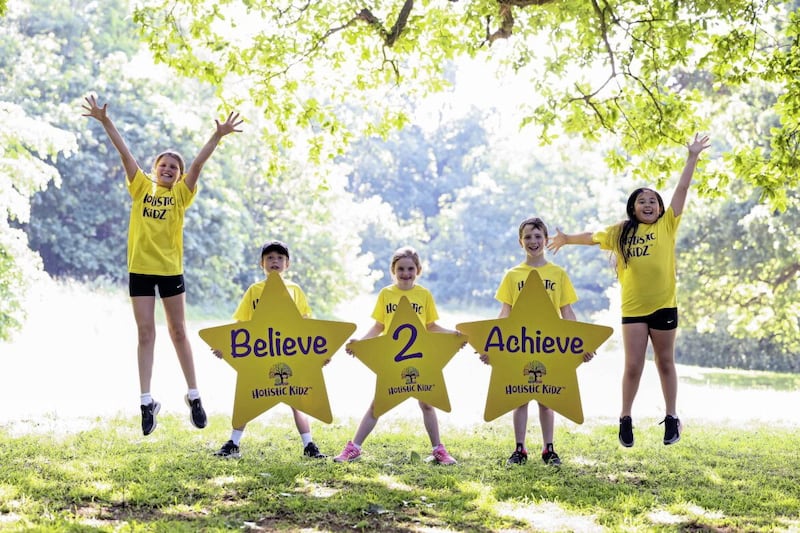MANY parents practise yoga both as a way to increase their strength and flexibility, and to give them a little peace and tranquillity amid the chaos of family life. What they may not have thought of is getting the kids to join in too.
Not only can it increase their strength and flexibility, but it can also help relax them, build their self-confidence and even help them sleep, says yoga teacher Dr Kiki Morriss, author of Nurturing Your Family With Yoga.
And what's more, says Morriss, who is also a medical doctor currently working with the Covid-19 vaccination programme, if the family does yoga together it can bring harmony to family life, as well as creating a bond through the shared interest.
"Family yoga will help you foster health and wellbeing for your whole family, bringing happiness and harmony to your home," she promises.
"As a doctor and yoga teacher, I'm constantly inspired by the potential of yoga to prevent and treat health conditions, as well as to relieve symptoms.
"Through my work, I'm reminded on a daily basis that yoga is powerful medicine and I'm a strong advocate for making it available on prescription in the NHS."
Morriss explains why she thinks getting the whole family involved with yoga is a good idea, and outlines a few moves children can try to get started.
Why is yoga good for children?
"Children need yoga as much as we do and there are many benefits, as it helps them build a strong and flexible body, achieve a peaceful and relaxed state of mind, sleep well, build self-confidence and improve focus, concentration and memory. It's also invaluable in helping them manage stress and anxiety, particularly as we navigate these challenging times."
How old should children be before they start yoga?
Mother-of-three Morriss says it's never too early to introduce children to yoga, and parents can start gentle baby yoga, which reinforces the bond between parent and child, when babies are just six-weeks-old. "Babies are natural yogis and you can watch them coming into poses without any need for tuition," she says.
"Young children approach yoga with a wonderful sense of joy and curiosity. They have natural flexibility and a good sense of balance. With gentle encouragement, they learn to focus and concentrate over time."
Early exposure to yoga lays the foundations for the teen and adult years, she says, acting as a powerful, preventative medicine and supporting good mental, physical and emotional health.
How do you get children to focus when doing yoga?
Morriss, who's been teaching children yoga for 20 years, suggests starting by teaching children a yoga pose beginning with the first letter of their name. "This always gets their attention," she says. "Then you can spell out their name using yoga poses."
Morriss says many yoga poses are named after and inspired by animals and nature, so parents can encourage children to imagine they are a pride of lions, a forest of trees, a meadow of butterflies, etc.
"Children love balancing poses. See how long they can balance in 'tree' while brushing their teeth," she suggests.
How often does a family need to do yoga to benefit from it?
Morriss says just doing yoga once or twice a week is great, but she urges parents not to worry too much about how often they're practising. Encourage your children to practise, but don't put pressure on them," she advises.
Is yoga alone enough exercise for children?
Official recommendations are that children aged five to 18 do at least 60 minutes of moderate intensity physical activity a day, as well as exercises to strengthen their muscles and bones.
Morriss says yoga poses are a great way to strengthen muscles and bones and can be used, along with other forms of exercise, to achieve the recommended level of physical activity.
What simple yoga positions can children start with?

Frog
1. Squat with your feet slightly wider than hip-width apart.
2. Lower your heels down to the floor, but don't worry if you can't bring them flat on the ground.
3. Place your hands on the floor in front of your feet.
Encourage children to squat regularly in the frog pose to keep their legs and back healthy. The pose will also support the healthy functioning of their digestive system.

Butterfly
1. Sit with the soles of your feet together and hold your ankles.
2. Close your eyes and take a few steady breaths in and out.
3. Imagine you're a butterfly and picture the colour and patterns of your wings.
Butterfly pose will calm and reassure your children, while helping to maintain the natural flexibility of their hips and strengthen their back.

Tree
1. Stand tall with your feet together.
2. Lift your right foot to the inside of your left leg.
3. Bring your hands into prayer position in front of your chest and then above your head.
4. Balance for as long as possible and then repeat on the other side.
Tree pose will strengthen children's legs and arms, improve their balance and develop confidence, focus and concentration. It will also develop their imagination, as they imagine they're palm trees on a sandy beach etc.

Nurturing Your Family With Yoga by Kiki Morriss is published by YogaWords, priced £16.99







